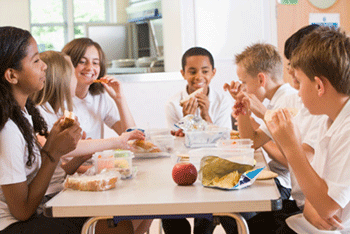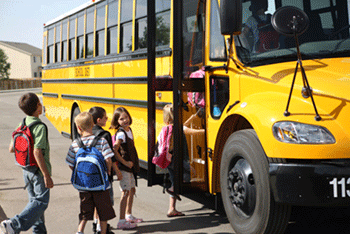Hint, hint. Keep reading to learn about a new funding opportunity to support children’s health and make 2016 a great summer for youth in your community.
 Many of you are probably familiar with the following statistic: During the school year over 21 million children rely on federal nutrition programs for free or reduced lunches, school breakfasts, snacks and dinner, but during the summer only 3.2 million of those children are receiving meals. Another perspective: In July 2014, only 16.2 children received summer meals for every 100 low-income students who received lunch during the 2013-2014 school years. That means, only one out of six children who needed summer meals received them — this is an enormous gap.
Many of you are probably familiar with the following statistic: During the school year over 21 million children rely on federal nutrition programs for free or reduced lunches, school breakfasts, snacks and dinner, but during the summer only 3.2 million of those children are receiving meals. Another perspective: In July 2014, only 16.2 children received summer meals for every 100 low-income students who received lunch during the 2013-2014 school years. That means, only one out of six children who needed summer meals received them — this is an enormous gap.
We know that park and recreation agencies are already working hard to make a difference in their communities across the country. As the leading providers of summer meals during out-of-school times, park and recreation agencies are at the forefront in addressing childhood hunger as well as providing millions of children with a safe, fun, educational and hunger-free environment each and every day. But how can we impact more children? How can we make sure that all youth are getting the nutrients and whole grains they need to grow up healthy? How can we continue to prevent summer learning loss in our communities?
To that note, NRPA recently attended a meeting at United States Department of Agriculture (USDA) headquarters to explore innovative ideas, problem solve and strategize about summer meals in 2016. The meeting brought together partners from multiple sectors in the fight against childhood hunger, each united by a common goal — let’s work to make 2016 the summer of opportunity for youth across the country! Many emerging trends and creative ideas were discussed at the meeting, but we’ve pulled out the best strategies applicable to parks and recreation.
Here are our top ways to increase summer meals and serve more youth in your community!
- Determine Where Meals are Needed. Utilize USDA’s Capacity Builder to determine where meal sites are currently located and where they may be needed. The capacity builder identifies area eligibility as well as open summer sites, multi-family housing, farmers markets, libraries, schools and more.
- Make Summer Camp the Focus, Not Summer Feeding. How are you marketing your programs? The City of Pittsburgh recently re-branded their meal service program with much success as “Grub Up”, opening their doors to all children in their communities and highlighting the great activities, programs and field trips throughout the session with the added bonus that food is included. This re-branding helped to eliminate the stigma associated with summer meals, resulting in an increase in the number of children served! Check out this great video on the Grub Up program. In addition, enrichment activities help to curb summer learning loss, keeping kids engaged in educational activities throughout the summer months.

- Use the USDA Summer Meals Toolkit to Plan and Market programs. The Summer Meals Toolkit includes tips for getting the word out through community-based outreach, information on program policy and administration, ideas for planning and collaborating with stakeholders, and shares program resources and best practices.
 Develop Key Partnerships. Engage local and state-level stakeholders in your programs to develop key partnerships. Get creative — look to partner with cross-governmental departments like housing and transportation to find ways to increase summer meals. For example, the city of Huntsville, Alabama offers free shuttle service to summer feeding sites for youth. Each child is given a free bus pass and the city created a route map highlighting summer meal sites. Want another creative idea? Jefferson County Public Schools (JCPS) in Kentucky purchased two used buses and converted them into mobile meal buses. The buses are able to go out into the community, meeting kids where they live and play, providing nutritious meals for children that normally wouldn’t get them. Learn more about the JCPS program.
Develop Key Partnerships. Engage local and state-level stakeholders in your programs to develop key partnerships. Get creative — look to partner with cross-governmental departments like housing and transportation to find ways to increase summer meals. For example, the city of Huntsville, Alabama offers free shuttle service to summer feeding sites for youth. Each child is given a free bus pass and the city created a route map highlighting summer meal sites. Want another creative idea? Jefferson County Public Schools (JCPS) in Kentucky purchased two used buses and converted them into mobile meal buses. The buses are able to go out into the community, meeting kids where they live and play, providing nutritious meals for children that normally wouldn’t get them. Learn more about the JCPS program.- Engage Volunteers. You can never have enough volunteers! A great way to expand meal programs is by utilizing volunteers. Community volunteers can be used to help transport meals or children to and from sites, serve meals, provide enrichment activities, promote programs, or increase staffing numbers. The City of Seattle Parks and Recreation department partnered with the AmeriCorps VISTA program in 2015 at summer meal sites, increasing capacity and meals served by having additional staff to support the program.
- Work with the Health Care Community. The American Academy of Pediatrics recently released a statement recommending that all pediatricians screen children for food insecurity. With this statement, there is hope that pediatricians will take a more active role in referring families to meal programs and resources they need. Connect with your local healthcare providers and make sure they are aware of local meal sites to refer patients.

- Hold a Summer Meals Kickoff Event. Gather your community for a kickoff event for summer meals. It’s the perfect opportunity to engage local policy makers, market your programs and get information into the hands of people that need it.
There’s no doubt about it — park and recreation agencies are an essential partner in the fight against childhood hunger. Incorporate some of these strategies in 2016 to give youth in your community the opportunity to play, the opportunity to learn, and the opportunity to be hunger-free.
What is your agency doing to make the 2016 the summer of opportunity? Let us know by commenting below!
Allison Colman is NRPA's Program Manager.

